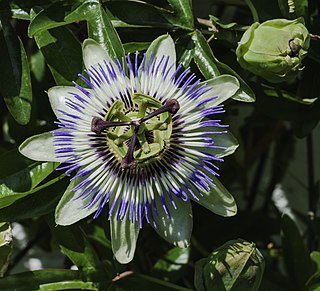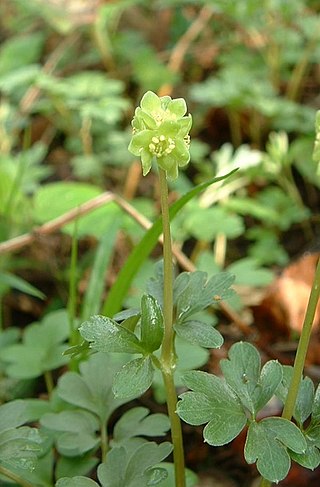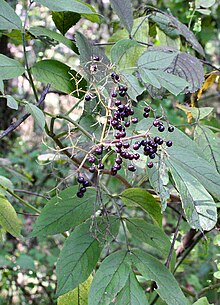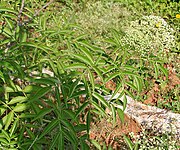
Sambucus is a genus of flowering plants in the family Adoxaceae. The various species are commonly referred to as elder, elderflower or elderberry. The genus was formerly placed in the honeysuckle family, Caprifoliaceae, but was reclassified as Adoxaceae due to genetic and morphological comparisons to plants in the genus Adoxa.

Prunus laurocerasus, also known as cherry laurel, common laurel and sometimes English laurel in North America, is an evergreen species of cherry (Prunus), native to regions bordering the Black Sea in southwestern Asia and southeastern Europe, from Albania and Bulgaria east through Turkey to the Caucasus Mountains and northern Iran.

Berberis, commonly known as barberry, is a large genus of deciduous and evergreen shrubs from 1–5 m (3.3–16.4 ft) tall, found throughout temperate and subtropical regions of the world. Species diversity is greatest in South America and Asia; Europe, Africa and North America have native species as well. The best-known Berberis species is the European barberry, Berberis vulgaris, which is common in Europe, North Africa, the Middle East, and central Asia, and has been widely introduced in North America. Many of the species have spines on the shoots and all along the margins of the leaves.

Passiflora caerulea, the blue passionflower, bluecrown passionflower or common passion flower, is a species of flowering plant native to South America. It has been introduced elsewhere. It is a vigorous, deciduous or semi-evergreen tendril vine growing to 10 m (33 ft) or more. Its leaves are palmate, and its fragrant flowers are blue-white with a prominent fringe of coronal filaments in bands of blue, white,yellow, and brown. The ovoid orange fruit, growing to 6 cm (2 in), is edible, but is variously described as having a bland, undesirable, or insipid taste. In South America, the plant is known for its medicinal properties, and is used by both the Toba and the Maka peoples.

Arctostaphylos uva-ursi is a plant species of the genus Arctostaphylos widely distributed across circumboreal regions of the subarctic Northern Hemisphere. Kinnikinnick is a common name in Canada and the United States. Growing up to 30 centimetres in height, the leaves are evergreen. The flowers are white to pink and the fruit is a red berry.

Adoxaceae, commonly known as moschatel family, is a small family of flowering plants in the order Dipsacales, now consisting of five genera and about 150–200 species. They are characterised by opposite toothed leaves, small five- or, more rarely, four-petalled flowers in cymose inflorescences, and the fruit being a drupe. They are thus similar to many Cornaceae.

Aquilegia canadensis, the Canadian or Canada columbine, eastern red columbine, or wild columbine, is a species of flowering plant in the buttercup family Ranunculaceae. It is an herbaceous perennial native to woodland and rocky slopes in eastern North America, prized for its red and yellow flowers. It readily hybridizes with other species in the genus Aquilegia.

Prunus serotina, commonly called black cherry, wild black cherry, rum cherry, or mountain black cherry, is a deciduous tree or shrub of the genus Prunus. Despite being called black cherry, it is not very closely related to the commonly cultivated cherries such as sweet cherry, sour cherry and Japanese flowering cherries which belong to Prunus subg. Cerasus. Instead, P. serotina belongs to Prunus subg. Padus, a subgenus also including Eurasian bird cherry and chokecherry. The species is widespread and common in North America and South America.

Sambucus ebulus, also known as danewort, dane weed, danesblood, dwarf elder or European dwarf elder, walewort, dwarf elderberry, elderwort and blood hilder, is a herbaceous species of elder, native to southern and central Europe and southwest Asia. The species is a well-established archaeophyte in much of the UK, and is also reportedly naturalized in parts of North America.

Solanum americanum, commonly known as American black nightshade, small-flowered nightshade or glossy nightshade, is a herbaceous flowering plant of wide though uncertain native range. The certain native range encompasses the tropics and subtropics of the Americas, Melanesia, New Guinea, and Australia.

Podophyllum peltatum is an herbaceous perennial plant in the family Berberidaceae. Its common names are mayapple, American mandrake, wild mandrake, and ground lemon. It is widespread across most of the eastern United States and southeastern Canada.

Edible flowers are flowers that can be consumed safely. Flowers may be eaten as vegetables as a main part of a meal, or may be used as herbs. Flowers are part of many regional cuisines, including Asian, European, and Middle Eastern cuisines.

Nandina domestica commonly known as nandina, heavenly bamboo or sacred bamboo, is a species of flowering plant in the family Berberidaceae, native to eastern Asia from the Himalayas to Japan. It is the only member of the monotypic genus Nandina. It is widely grown in gardens as an ornamental plant with a number of cultivars that display bright-red fall foliage in the cool months, and attractive new foliage growth in spring. Although a popular ornamental shrub, the berries are toxic to birds, especially towards the end of the winter when other food sources become scarce.

Sambucus nigra is a species complex of flowering plants in the family Adoxaceae native to most of Europe. Common names include elder, elderberry, black elder, European elder, European elderberry, and European black elderberry. It grows in a variety of conditions including both wet and dry fertile soils, primarily in sunny locations. The plant is widely grown as an ornamental shrub or small tree. Both the flowers and the berries have a long tradition of culinary use, primarily for cordial and wine.

Sambucus racemosa is a species of elderberry known by the common names red elderberry and red-berried elder.

Sambucus gaudichaudiana, commonly known as white elderberry, is a species of flowering plant in the family Adoxaceae and is endemic to eastern Australia. It is a perennial shrub but with stems that are produced annually with pinnate leaves that have three to eleven leaflets, small white flowers and small but edible fruit. It grows in cool forest and shady gorges.
Sambucus mexicana may refer to the following North American black or blue elderberry species:

Sambucus cerulea or Sambucus nigra ssp. cerulea, with the common names blue elderberry and blue elder, is a coarse textured shrub species of elder in the family Adoxaceae.

(R)-prunasin is a cyanogenic glycoside related to amygdalin. Chemically, it is the glucoside of (R)-mandelonitrile.

Sambucus pubens, the American red elder, is a species of elder (Sambucus) native to eastern North America. The inflorescence is a rounded panicle, making the plant easy to distinguish from the more common S. canadensis, which has a more open, flattened corymb. Some authors have considered S. pubens to be conspecific with S. racemosa L.
























